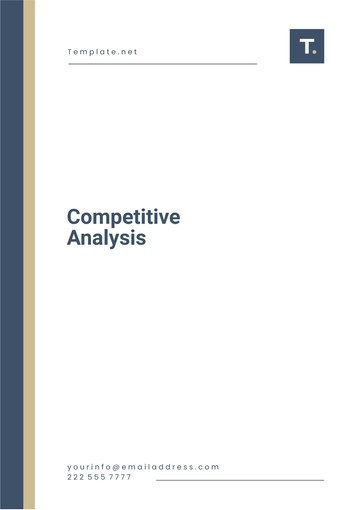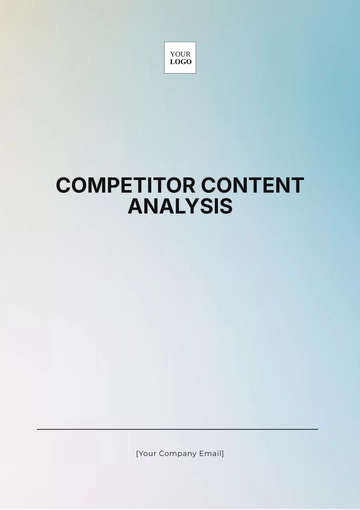Free Strategic Analysis

Prepared By: | [YOUR NAME] |
Department: | [YOUR DEPARTMENT] |
Company: | [YOUR COMPANY NAME] |
I. Executive Summary
The Executive Summary provides a succinct overview of the key findings and recommendations of the strategic analysis.
The [Your Company Name] strategic analysis for the year 2050 highlights the organization's current position in the market and outlines key strategies for future growth.
Key findings include an assessment of market trends, internal capabilities, and competitive landscape.
Recommendations focus on leveraging emerging technologies, expanding into new markets, and enhancing operational efficiency to maintain a competitive edge in the rapidly evolving business environment.
II. Organizational Overview
The Organizational Overview offers a comprehensive understanding of the organization's mission, vision, values, and current strategic objectives.
A. Mission, Vision, and Values
Mission: To empower individuals and businesses worldwide through innovative solutions that drive positive change and sustainable growth.
Vision: To be a global leader in renewable energy solutions by pioneering cutting-edge technologies and fostering a culture of collaboration and excellence.
Values:
Integrity
Innovation
Customer-centricity
Diversity and inclusion
B. Strategic Objectives
Market Leadership: Solidify our position as the market leader in smart home automation systems by 2055.
Global Expansion: Expand our presence into emerging markets in [Region] by 2060.
Sustainability: Achieve carbon neutrality and implement environmentally sustainable practices across all operations by 2065.
III. SWOT Analysis
The SWOT Analysis evaluates the organization's internal strengths and weaknesses, as well as external opportunities and threats.
A. Strengths
Established brand reputation and loyal customer base
Robust R&D capabilities driving continuous innovation
Strong financial performance and healthy cash reserves
B. Weaknesses
Overreliance on a single product line for revenue generation
Limited penetration in certain geographic regions
Talent retention challenges in highly competitive markets
C. Opportunities
Growing demand for eco-friendly products and services
Advancements in artificial intelligence and automation technologies
Strategic partnerships with government agencies and NGOs for social impact initiatives
D. Threats
Intense competition from agile startups and tech giants
Regulatory changes impacting industry standards and compliance requirements
Economic downturns and geopolitical uncertainties affecting consumer spending patterns
IV. Competitive Analysis
The Competitive Analysis examines the competitive landscape, including key competitors, market share, and competitive advantages.
A. Key Competitors
Competitor 1: A leading provider of smart home automation solutions specializing in advanced AI integration for seamless user experience.
Competitor 2: An established player in the smart home industry known for its customizable and scalable automation platforms catering to diverse consumer needs.
Competitor 3: A rising competitor offering innovative smart home products with a focus on energy efficiency and sustainability.
Competitive Analysis
Competitor | Market Share | Competitive Advantages |
|---|---|---|
Competitor 1 | 20% | Proprietary technology and intellectual property portfolio |
Competitor 2 | 15% | Strong distribution network and partnerships |
Competitor 3 | 10% | Focus on customer experience and customization options |
V. Recommendations
The Recommendations section provides actionable insights to enhance the organization's strategic position and address identified challenges.
A. Strategic Initiatives
Innovation Hub: Establish an innovation hub to foster collaboration and accelerate the development of breakthrough technologies.
Global Market Entry: Develop a comprehensive market entry strategy for key emerging markets, prioritizing localization and cultural adaptation.
Sustainability Roadmap: Implement a sustainability roadmap with clear targets and milestones to reduce carbon footprint and promote environmental stewardship.
B. Implementation Plan
Initiative | Timeline | Responsible Parties | KPIs |
|---|---|---|---|
Initiative 1 | 2051-2053 | R&D Department | Increase in market share: 10% by 2055 |
Initiative 2 | 2052-2054 | Business Development | Expansion into 5 new markets |
Initiative 3 | 2053-2055 | Sustainability Team | Reduction in carbon emissions by 25% by 2055 |
VI. Conclusion
In conclusion, the strategic analysis identifies key areas for [Your Company Name]'s growth, emphasizing its strong brand reputation and innovative capabilities. Leveraging these strengths, strategic initiatives such as innovation hubs and global market expansion are recommended to enhance competitiveness and foster sustainability. Effective execution and adaptation will be crucial for [Your Company Name] to maintain its market leadership and drive long-term success.
- 100% Customizable, free editor
- Access 1 Million+ Templates, photo’s & graphics
- Download or share as a template
- Click and replace photos, graphics, text, backgrounds
- Resize, crop, AI write & more
- Access advanced editor
Unlock strategic insights with Template.net's Strategic Analysis Template. Fully editable and customizable, this tool allows for tailored assessments of your business landscape. Utilize our Ai Editor Tool to effortlessly personalize it to your needs, empowering informed decision-making. Streamline strategic planning and enhance performance with precision and efficiency. Dive into strategic analysis with Template.net's professional template today.





























